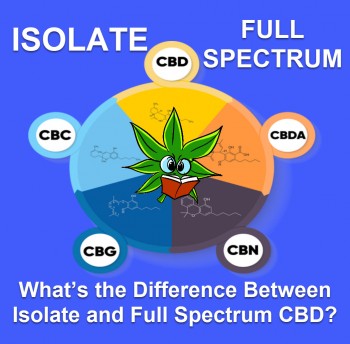Meet CBM, A 'New' Cannabinoid Extracted From Hemp

The cannabis plant is one very fascinating plant which seems like a never-ending mystery which keeps churning out new things the deeper you dig. This is why there are always new findings in terms of the characteristics of the existing components or the discovery of new ones. The plant has about 100 or more cannabinoids including THC and CBD which are the most popular and most analyzed of them over time. Besides these, there are also other components such as flavonoids and terpenes which contribute to the overall aroma, flavor, and taste of the plant.
The discovery of new cannabinoids from the hemp plant is very exciting as it shows promise and good possibilities for humankind, this is why there is consistent research going on to figure out new things. For anyone going through the abundant cannabis products available, it is quite easy to see that the existence of other cannabinoids can prove to be quite useful in treating and ameliorating various medical conditions.
A cannabinoid called Cannabimovone (CBM) was recently discovered in a hemp plant known as Carmagnola and has been recognized as a cannabinoid with some unique benefits to offer. These benefits could include advances in the treatment of diabetes, eating, and metabolic disorders. The Carmagnola strain is named after the village in Piedmont, near Turin in Italy where it was found. This village is known historically to specialize in growing hemp for use in making things such as sails, nets, ropes, and marine wear.
It was discovered in research carried out by a group of Italian research centers and universities. Their findings published in March 2020 in Molecules, a research journal claims that this cannabinoid works differently from THC and CBD though its biological structure is similar to that of CBD. Research also indicated that CBM might be able to boost metabolism and suitable insulin levels in the body. They were also able to achieve the synthesis of both cannabimovone and anhydrocannabimovone cannabinoids.
PPAR Receptors and CBM Mechanisms
Cannabinoids have a natural characteristic of binding with receptors to carry out their actions in the body. CBM followed this same guideline and seemed to have a special connection with PPARγ as it showed the highest potency with it though it was able to bind to both of these receptors. PPARγ (gamma) is one of the Peroxisome proliferation-activated receptors (PPARs) which are responsible for controlling organ cell generation and regulating hormone cells in the body. Also, they play crucial roles in the regulation of all metabolic movements, immune functions, and energy homeostasis. These PPARs are of three types but the study concentrated majorly on PPARα (alpha) and PPARγ (gamma) and it was carried out through the use of cell culture assessments and 3-D computational models.
As a result of recent studies into the role of PPARγ regarding immune and inflammatory responses, it must be activated to remedy conditions like Parkinson's, Huntington's Disease, and Multiple Sclerosis which are neuroinflammatory. This means that the ability of CBM to activate PPARγ will not only help in remedying these conditions but could also initiate gene expression through a positive feedback loop.
Prospects
The discovery of CBM through research is an important step in the move towards getting an insight into its possible benefits and the possibility of the discovery of more cannabinoids. This allows us to closely monitor their interactions with the endocannabinoid system and the receptors within the human body to see any potential this could offer in the treatment of various conditions such as eating and metabolic disorders, diabetes among others. This was backed up by the assertion of researchers regarding the ability to promote insulin signaling thus making it useful in the development of anti-diabetic drugs. What this means is that a combination of cannabinoids such as THC, CBD, CBM, THCV, and any other cannabinoid with insulin-regulating properties can be used in the production of an anti-diabetic drug.
Furthermore, CBM could serve as an addition to terpenes and cannabinoids in creating synoptic cannabis extracts. This is because studies indicate that these cannabinoid products need to be all-inclusive by incorporating the minor cannabinoids to enhance the effects of THC and CBD which are the major cannabinoids. Despite possibilities that CBM is available in other cultivars, it is hoped that breeders will consider crossing Carmagnola with other strains in a bid to harness its high content level for the creation of other varieties that will contain equally significant amounts of CBM.
It is important to keep in mind that much effort is being put into these studies because cannabinoids do not only seem safer but also have several potential that can be harnessed for the benefit of mankind and extensive studies are constantly being conducted to make this a reality.
CANNABINOIDS WE ARE LEARNING ABOUT, READ MORE...
WHAT IS CBDA, AND HOW CAN WE USE IT IN NEW MEDICINE?








